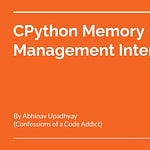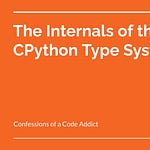Yesterday we concluded the live session on the internals of the CPython virtual machine (VM) or the bytecode interpreter implementation. This is the recording of that session.
Accessing the Recording: This session was done exclusively for the paid supporters of Confessions of a Code Addict. To access the recording, consider upgrading to a paid subscription, or you can also purchase it directly at the below link.
Following is an AI generated summary of what was discussed during the session.
Meeting summary for CPython Virtual Machine Internals (04/27/2024)
Quick recap
Abhinav provided insights into Cpython's virtual machine, including its dispatch mechanism, byte code optimization, and the role of interpreters. He explained stack frames, recursion limits, and the main interpreter loop's implementation. Additionally, he discussed potential improvements like second-tier interpreters and the JIT compiler.
Summary
Cpython Virtual Machine Explained
Abhinav provided an in-depth explanation of the Cpython virtual machine, focusing on its dispatch call and switch case implementation. He highlighted the popularity of Cpython due to its compatibility with various libraries. Furthermore, he explained the role of tier one and tier two byte codes in improving code performance and the overall design of a typical virtual machine.
Virtual Machine Architectures and Cpython Interpreter
Abhinav discussed the fundamental concepts of virtual machine architectures, specifically the register-based and stack-based approaches. He explained the advantages and limitations of each approach, as well as their use in various programming languages. He also delved into the process of translating high-level programs into machine-readable instructions, using the example of the Cpython Bytecode interpreter. Abhinav highlighted the role of the bytecodes.c file, the handling of specific instructions, and the execution of the interpreter.
Virtual Machine Execution and Cpython
Abhinav explained the workings of a virtual machine and its stack-based execution, detailing the process from compilation to execution, including the interpretation process and the use of the stack for handling operations. He also discussed the implementation of a general virtual machine, the differences between assembly and byte codes, and the potential for a combination of registers and virtual machines.
In addition, he provided an in-depth explanation of Cpython's bytecode format and optimization process, mentioning his recent article on runtime internals and his plans to cover the tier 2 micro interpreter and a jit compiler in future articles.
Python Program Execution and State Management
Abhinav explains that when executing a Python program, the Cpython runtime initializes an interpreter and a thread associated with it to hold the execution state. He discusses the PyRuntimeState struct in the, which represents the global state of the Cpython process and contains references to the main interpreter and thread.
Understanding Interpreters in Python
Abhinav clarified the concept of interpreters in Python, explaining that while there's only one main interpreter, it's possible to have multiple sub-interpreters. He elaborated on their use cases, such as isolating user input and addressing the global interpreter lock's performance issues.
He also discussed the runtime State object, focusing on the interpreter state and its components, including the main interpreter, main thread, and thread state. Abhinav emphasized the importance of the main thread and its dedicated pointer in the interpreter state, and the structure of the thread state as a doubly linked list.
Cpython Recursion Tracking and Stack Frames
Abhinav explained the runtime tracking of recursion limits in Cpython, focusing on the creation and function of stack frames. He detailed how each function call generates a stack frame containing local variables, the stack, instruction pointer, and other essential data. Ravi confirmed his understanding of the stack frame definition within Cpython. Abhinav further clarified the structure and function of the stack frame, emphasizing that each function has its own stack, and the current top of the stack can be calculated by adding the 'locals plus' and 'stack top' fields. He also clarified that stack frames do not cross into other stack frames. Abhinav concluded by providing a visual demonstration to further explain the concept.
Python Interpreter Stack Frame ExplainedA
Abhinav explained the intricacies of a stack frame in the context of a Python interpreter. He detailed the creation of a frame object when a function is called and the role of the 'py_eval' function in evaluating the frame object. He also introduced the flexibility of providing a custom 'eval' function and discussed the implementation of the main interpreter loop.
Furthermore, he explained the 'dispatch' macro, the optimization feature of Computed Gotos in C compiler, and the handling code for all 223 instructions supported by Cpython.
Performance and Interpreter Updates in Python
bohuslavsimek expressed interest in the performance of computer go-to statements and big switch statements in Python, questioning whether there had been any recent improvements in this area. He also asked about the second-tier interpreter and how it differed from earlier versions. Lastly, he showed interest in understanding how the JIT compiler is integrated into Python. Abhinav thanked everyone for their participation and invited them to subscribe to 'confessions of code addict' for future sessions.



















